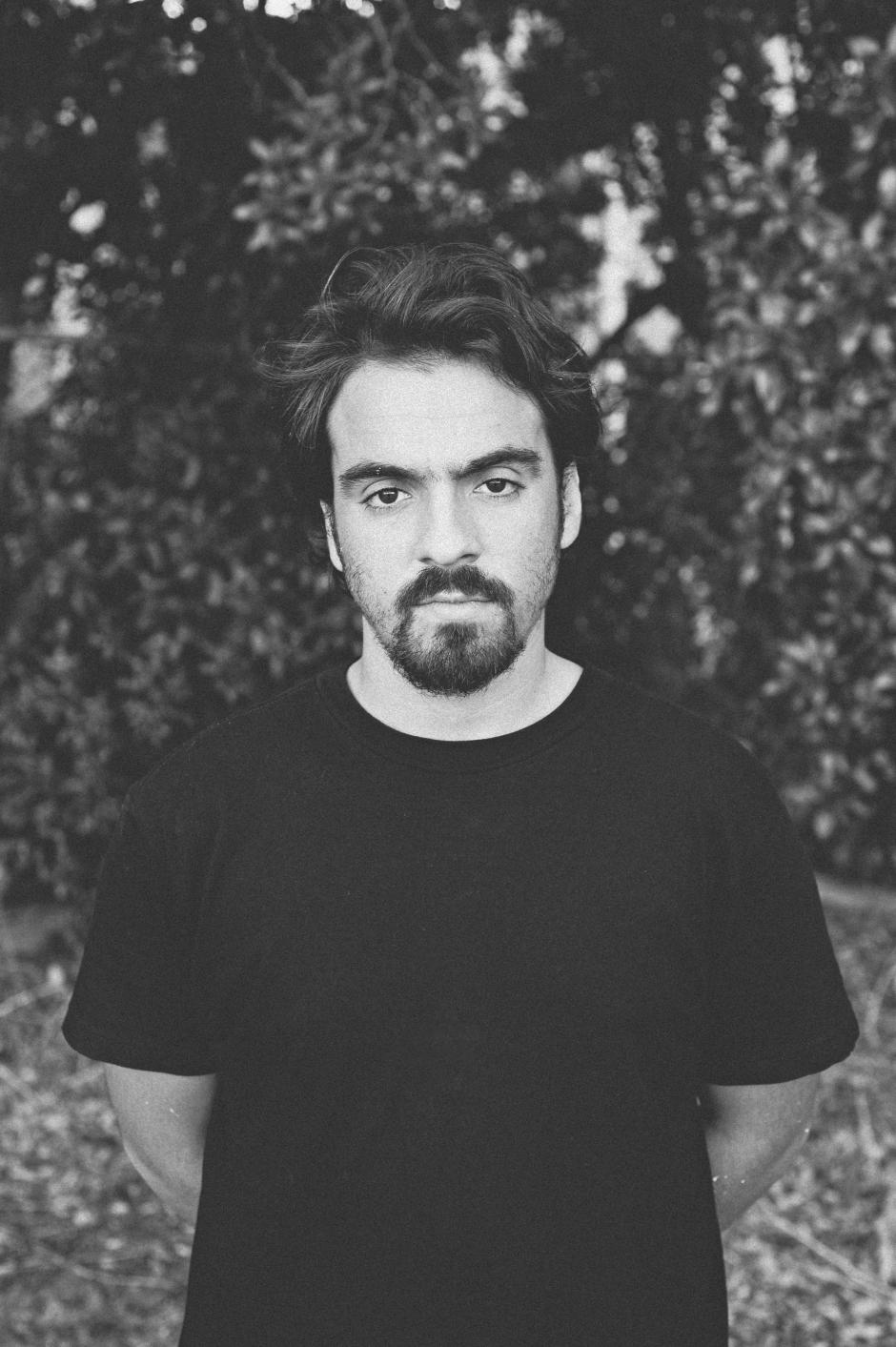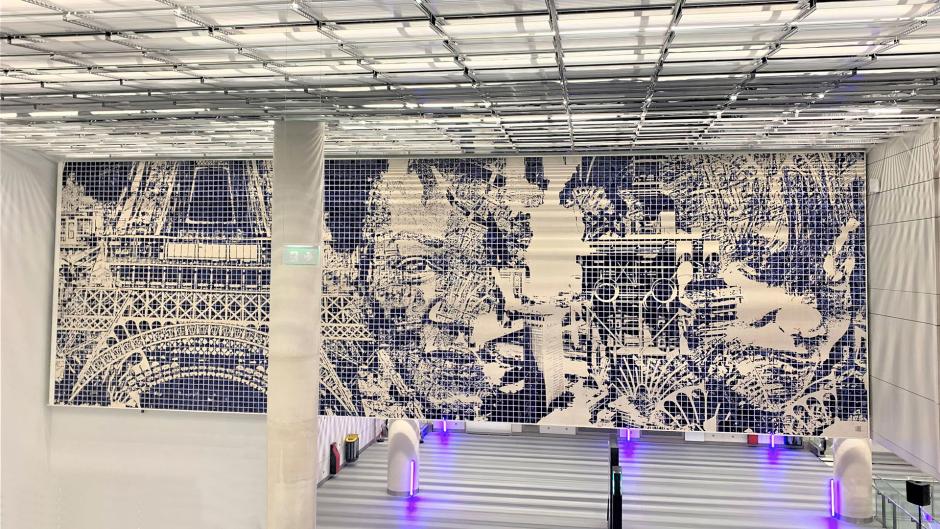Ardian sponsors Alexandre Farto aka VHILS’ “Strates Urbaines” mural at the new Orly Airport station in France
Growth stories
Ardian sponsors Alexandre Farto aka VHILS’ “Strates Urbaines” mural at the new Orly Airport station in France
-
20 June 2024
Reading time: 7 minutes
Ardian is a corporate sponsor of Grand Paris Express, Europe’s biggest transport infrastructure project, involving the construction of 68 new metro stations and 200km of track orbiting the French capital. This huge rapid transit project is designed to transform urban mobility for millions of users, as the population of the Île-de-France region increases. The Grand Paris Express will improve connectivity between the districts that surround Paris and make the region more attractive and economically dynamic.
The project’s planners decided to showcase its aesthetic ambitions by pairing architects with artists to incorporate public art works into the designs for the new stations. The €1 million sponsorship that Ardian provided is funding works of art at two new stations serving airports: Orly and Le Bourget.
The new Orly Airport station is expected to handle around 95,000 journeys a day, illustrating its importance as an economic hub: there are 173,000 jobs based within a 1km radius of the station, of which 28,000 are connected to the airport.
To welcome all travelers, the new Orly Airport station invites the Portuguese street artist Alexandre Farto aka VHILS, who has created “Strates Urbaines”, a huge mural made up of more than 11,000 azulejos – Portuguese ceramic tiles. His striking vista, in which faces blend into the Paris cityscape, greets travellers as they pass through the new station, which was designed by François Tamisier, Chief Architect of Aéroports de Paris.
Here we speak to VHILS about the Orly Station project that Ardian has sponsored and about his career as an internationally renowned urban artist.

Born in Portugal in 1987, street artist Alexandre Farto, who goes by the professional name VHILS, started out as a graffiti writer in the early 2000s. He grew up in Seixal, an industrialised suburb near Lisbon and rose to fame thanks to his innovative bas-relief carving technique. Since 2005, he has presented his work in more than 30 countries around the world.
© Vera Marmelo
Alexandre Farto aka VHILS’ vision for the “Strates Urbaines” mural that Ardian has sponsored
What was your vision for your work, “Strates Urbaines”, at Orly Airport Station?
The station is a place of transition so I wanted to create something that would connect with people as they move through it. In the time it takes you to go down the escalators towards the mural I want you to relate to it powerfully, but also to interact with it because you are moving so your point of view is changing. The idea was to create something that would change as you moved, with different points of view, different reflections or shadows. I wanted to create something that was interactive and not a static artwork.
It includes the central element of Paris, which is the Eiffel Tower, as well as huge blueprints of the map of Paris that emerge from the blue tiles in the second layer and other iconic buildings that the station can connect you to. But it is also meant to welcome you, so I created the portraits that you see to give glimpses of people that are welcoming you and bringing you to your destination. I wanted an experience that would last for 15 or 30 seconds, one minute, as you pass by, where you see the city but also the people that live in that city and welcome you to it.
Tiles are a material used in stations everywhere. I tried to subvert them by carving into them and creating a surface where the cobalt blue areas are like a mirror so that you see your own reflection as well as the images in front of you. The idea was to create this surface that would absorb the life of the station.
The people that pass through the station see themselves in the artwork – in Paris. So it is a symbiotic work that brings you to Paris and welcomes you, but also lets you see yourself in Paris.
How Alexandre Farto aka VHILS developed the technique he calls ‘urban archaeology’
How did you develop your distinctive way of creating art?
I was born and raised in Seixal on the south side of Lisbon, which used to be the industrial area, 20 or 30 minutes from the city center. That is where I started graffiti painting on walls when I was a teenager.
But after a while I began thinking about what a wall is, what that surface represents, and I realized that these walls in public spaces were absorbing history and the passage of time, and that there were murals trapped inside them.
I developed this concept of urban archaeology, of digging into walls and painting with the layers that were already there. Instead of adding, like everyone was doing, the idea was to subtract, exposing the layers that were underneath and painting with the layers of time, sometimes to create portraits, sometimes typography and sometimes murals.
Later on, I went to London to study and met other artists that were pioneers of the urban art movement as well. That encouraged me to push the boundaries of what could be created in public spaces. The main purpose of my work, I would say, is to create a dialogue between the city and the people, to humanize the city and show the potential of all the materials that cover it. I try to subvert the surfaces or go through them to reveal the insides of the city or the underlying histories that the city has trapped inside it.
His rise to international prominence as an urban artist
When did you start to attract attention from galleries and the professional art world?
When I was around 17, I organized an exhibition in an empty building in Lisbon with other artists who were working in public spaces in the city. That was when my first gallery, Vera Cortês, started to show interest. They are very important to me because they were the first to give me a shot at doing a show in a gallery. That brought me to the attention of the art world for the first time. Then I went to study at Central St Martins in London and crossed paths with artists like Banksy and JR that were creating a buzz.
Eventually I was invited to be part of the Cans Festival, which Banksy organized in 2008 underneath Waterloo Station. That was when my work got shown next to Banksy’s and that attracted a lot of attention. From that point I started getting invitations to do projects for cities, festivals and galleries around the world.
The impact of urban transformation on Alexandre Farto aka VHILS work
How would you say your work has evolved since you started?
Your work naturally evolves as you mature, but I think the major evolution for me was that I saw the power of urban transformation in the place where I was born. I was able to see the results of Portugal going from the revolution in 1974 to joining the EU in 1986. I saw a change in the visual aspect of the walls. They went from murals showing people’s dreams and aspirations to billboards for a consumer society and then graffiti.
And then there was also the transformation of new infrastructure like the railway that arrived in my town in the suburbs. That connected me to a bigger city and brought a lot of good things with it but changes like that also have the power to transform the way we perceive our environment.
I saw a huge transformation from the early 1990s until today, but the pace of transformation I saw was very specific to my reality at the time, which was mostly Portugal and Lisbon.
When I started travelling and doing projects in other cities, I realized that transformation was happening way faster in other places – it was not just my city that was being transformed, it was the whole world. So, what I try to do is to capture this moment of transformation that is happening in society – culturally, economically all over the world – and eternalize it. There will be a before and after, but I want to capture this moment of transformation when things are evolving faster than they ever have in history. We should take time to slow down and look and try to communicate with what we have right now, even if that is a very difficult exercise for humans.




